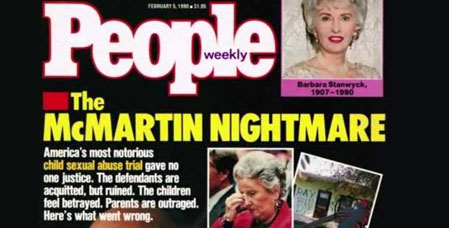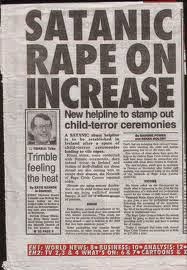
Sexual abuse in daycare facilities became a hot-button issue in the 1980s. Allegations of pedophilia, Satanism, and rampant abuse sparked outrage in the American consciousness.
Kern County Child Abuse Trials
Alvin and Debbie McCuan had two daughters, who in 1982 alleged that their parents were part of a sex ring that included two others, Scott and Brenda Kniffen. The Kniffens’ two sons also alleged abuse. As a result of the trial, both couples were convicted and were sentenced to over 1000 years in prison.
There were six other cases in the same county, including a carpenter named John Stoll, who was convicted and sentenced to 40 years for 17 counts of lewd and lascivious conduct.
Grant Self, who rented Stoll’s pool house, had a previous conviction for child molestation. He was again convicted in connection with the Kern County cases.
These cases, which sparked a national crisis, were later overturned en masse. The Kniffens’ and McCuans’ convictions were overturned in 1996 and they were released. Stoll’s conviction was reversed in 2004. However, he was not released. He was instead sent to a mental hospital for sexual offenders due to his two prior convictions. While he was freed in 2009, he was rearrested in 2012 and plead guilty to sexually abusing three boys.
Much was learned from this trial, albeit at a later date. It became clear that physical evidence was extremely important in child abuse trials because children can be susceptible to leading questions. The Kern County trial relied only on the testimony of children and no physical evidence was ever found.
McMartin Preschool Trials
The McMartin family operated a preschool in Manhattan Beach, California in 1983. Ray Buckey, the grandson of school founder Virginia McMartin and son of administrator Peggy McMartin Buckey, was accused of abusing Judy Johnson’s son, who was a student at the preschool. Johnson noticed painful bowel movements in her son and accused Buckey of abuse. She later accused administrators of sexual encounters with animals and even accused Buckey of flying. Johnson, who admitted before Buckey’s trial that she was mentally ill, passed away in 1986 of complications related to alcoholism.

On March 22, 1984, Virginia McMartin, Peggy McMartin Buckey, Ray Buckey, Ray’s sister Peggy Ann Buckey and teachers Mary Ann Jackson, Betty Raidor, and Babette Spitler were charged with 115 counts of child abuse, later expanded to 321 counts of child abuse involving 48 children. The prosecutors relied mainly on the students’ testimonies, who accused the administrators of hosting Satanic rituals, constructing underground tunnels, and traveling in a hot-air balloon. However, this testimony was inconsistent and difficult to prosecute. The then-District Attorney was losing an election and when the new DA took power in 1986, he called the evidence against Virginia McMartin, Peggy Ann Buckey, Mary Ann Jackson, Betty Raidor and Babette Spitler “very weak.” He dropped all charges against them.
Buckey and Peggy McMartin were jailed during their trial and George Freeman, a cellmate of Buckey, claimed that Buckey had confessed to him. However, Freeman later tried to flee the country and confessed to a series of instances where he had perjured his testimony in exchange for favorable treatment.
Peggy McMartin was cleared of all counts after three years of testimony and nine weeks of jury deliberations in 1990. Buckey was eventually cleared after spending five years in jail. The trail was the longest and most expensive trial in the history of the United States at the time, and it resulted in no lasting convictions. Seven years and $15 million dollars were spent attempting to prosecute the accused.
However, this case did spark an increase in funds related to child abuse research, and the National Center on Child Abuse and Neglect (NCCAN) received a budget increase from $1.8 million to $7.2 million between 1983 and 1984. The budget jumped to $15 million in 1985. This funding went towards programs related to preventing sexual and physical abuse of children, and has shaped the modern view of the affects of child abuse. Increased federal funding was also provided to states to hold conferences on ritual abuse as a result of the trials. These were intended to show prosecutors how child abuse trials should be conducted and how to weed out potential suits that may be outlandish.
What can we learn from these trials?
Much was learned from these trials that was used in later cases involving abuse of children. Child psychology was advanced as a result of the trials, and the American Psychological Association performed a study after the fact which revealed that children, when interviewed, will often incorporate aspects of an interviewer’s question into their answers in an attempt to give the interviewer the answer the child thinks is sought. This means that interviewers can often illicit answers that may be embellished. It takes skilled investigators to sort through the intricacies of a child’s testimony.
Further, much of the interviews in these trials involved repeated questioning of children, which can lead to children changing their answers in order to give what they perceive as the “correct” answer. As a result, repeated questioning in recent child abuse trials has been abandoned.
The effects of peer pressure on children’s testimony was investigated as well. Studies conducted after the trials showed that children who are told that his or her friends have already testified about an event are likely to create a similar story. Thus any interviewer must be extremely careful not to bias the child. Further, it is important that the interviewer not reveal his authority because if a child perceives the interviewer as an authority figure – like a police officer – they are more likely to go along with that person’s biases.
There was a cultural impact as a result of the trials as well. The popular character Snuffleupagus on “Sesame Street” was finally revealed to the adult characters of the show in response to the trials. Snuffleupagus was a friend of Big Bird which was considered imaginary by the adults on the television show. The creators did not want to scare children into thinking that adults would not believe them in cases of abuse. So, they revealed Snuffleupagus as real on the television show in an effort to emphasize the idea that children should be open to their parents about abuse.
While the trials of the 80s resulted in American citizens being unfairly prosecuted (and it is important to emphasize that in these cases, most of those involved were exonerated), Americans became more aware of the potential dangers of child abuse. As far as the legal system is concerned, much was learned about the evidence-gathering process for child abuse trials. The importance of consistent testimony coupled with physical evidence was emphasized. Child psychology received a much needed budgetary boost and interest in that under-funded area grew tremendously. Much of what we now know about child psychology was shaped by the growth in that field, much of which could be credited to these trials.


